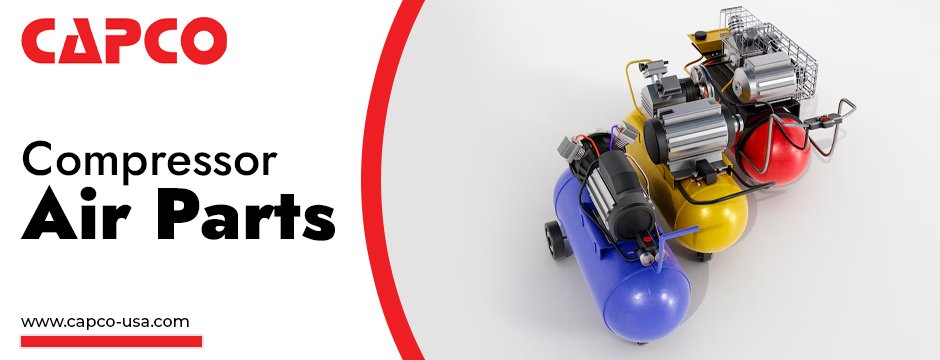
Air compressors are essential machinery in the majority of industries. They drive equipment, inflate tires, and do numerous other jobs within automotive repair shops to large factories. But as with any machine, compressors also contain parts that wear out over time. If these parts are not maintained or replaced at the time, they will result in costly failures.
In this blog, we’ll explain how to identify worn-out compressor air parts before they cause major problems. We’ll keep it simple and practical so that anyone can understand and act in time.
Why It’s Important to Catch Wear Early
Every compressor has several air parts that work together to produce clean and pressurized air. These include valves, pistons, filters, hoses, seals, and gaskets. If any of these parts become damaged, the compressor may lose efficiency or stop working completely.
Early detection saves you:
- Money on costly repairs
- Performance
- Compressor life
- Safety for people and the environment
Let’s examine the frequent signs of worn-out compressor air parts.
1. Unusual Noises from the Compressor
Compressors will hum or pulse continuously when running. But if rattling, grinding, hissing, or knocking sounds are coming from the compressor, something may be wrong.
Possible reasons:
- Failed or damaged pistons and bearings
- Cracked seals or hoses
- Broken or loose valves
These are generally signs that components are going bad or have already done so. Never ignore new or unfamiliar noises.
2. Abrupt Loss of Air Pressure
One of the easiest signs to find is reduced air pressure. If your tools are not getting proper pressure or the compressor is taking more time than usual to build pressure, it could be due to:
- Worn valves or piston rings
- Hoses or fittings leak
- Compressed air filter clogs
Slowed productivity caused by reduced air pressure. You may be consuming extra energy for inferior outcomes.
3. Higher Energy Consumption
A good working air compressor uses a consistent amount of electricity. But if your electricity usage goes up without any rationale, then your compressor will not be able to work.
Damaged compressor air parts cause the unit to work more than necessary. For example, if there is a small air leak, then the compressor keeps running in order to maintain pressure, using additional power.
4. Air Leaks or Moisture Buildup
A properly kept up air compressor will have sealed, dry lines. However, when they wear out, it’s not uncommon for there to be air leaks. You may find a constant hissing sound or a loss of tank pressure.
Ripped gaskets, broken hoses, or old connectors are usually the reason for the leak.
Also, when the moisture trap becomes full prematurely or there is more water in the tank than necessary, the separator or filters become exhausted. The compressor and tools that are mounted on it will be destroyed by moisture if not checked.
5. Excessive Vibration
There is always a bit of vibration, but if the compressor starts shaking very violently, it may mean that:
- Mounting bolts are loose
- Internal parts are out of balance
- Bearings or pistons are worn out
Heavy vibration puts excessive stress on the machine. It may also crack or injure nearby parts.
6. Overheating Issues
With wear and tear on air components, the compressor will be forced to operate for a longer period to achieve the same function. This naturally results in overheating.
Watch for:
- Hot casing on the compressor
- Warning signs on electronic control panels
- Burning smell from the motor
Overheating not only destroys the compressor but increases the chance of fire under severe circumstances.
7. Grime or Dust in Output Air
Compressed air should be dust-free and free of oil. If you see dirty or oily air coming from the hose, the separators or air filters may be worn out.
Dirty air may clog equipment, damage machinery, or ruin products in delicate applications like painting or food processing.
8. Breakdowns or Shutdowns
If your compressor is continuously turning off or displaying error codes, it may be suffering from neglected air parts.
Repeated repairs are usually signs of a deeper issue. Instead of keeping fixing the same component over and over again, attempt to find out the overall system for worn-out components.
How to Be Proactive
In order to avoid emergencies, make a habit of routine inspection and maintenance of compressor parts. Here are a few easy steps you can take to stay ahead:
– Create a Maintenance Schedule
Schedule dates for filter cleaning, oil level checks, belt and valve checks, and tightening of connections.
– Spare Parts on Hand
Keep common air parts like filters, hoses, and gaskets readily available. This avoids long downtimes if replacements are needed.
– Utilize a Professional Technician
In case of uncertainty regarding the issue, contact an expert technician. They can easily find worn parts and work safely.
– Spend on Quality Parts
Cheap or counterfeit parts wear out faster. Purchase only from trusted sources to ensure better performance and increased lifespan.
Conclusion
Damaged compressor air components are a sneaky threat. They may not always cause sudden failure but slowly drain your machine’s performance, safety, and efficiency.
By watching for signs of noise, leaks, overheating, and low pressure, you can head off trouble before it gets big. Maintenance, regular replacement, and the use of quality parts will ensure your compressor is healthy for many years.
Don’t wait until there’s a complete failure. Catch trouble early—and take action from Capco USA before it’s too late.




